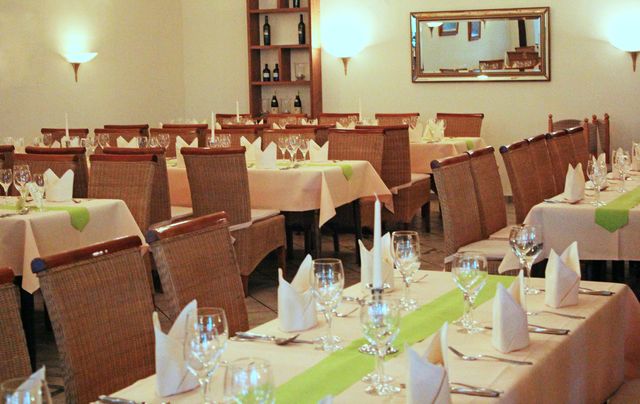How to set a table: an instruction
 Not only the tasty food itself, but also a perfectly set table determines whether a celebration is successful and a good atmosphere is created. Also, a meal served in a harmonious environment and sitting at an invitingly set table is much more digestible. A beautifully laid table with exquisite table linen is a great way to honour your guests. Such a table shows that one has thought about and wishes the well-being of the guest. In the following we have developed a small guide for you on how to set a table, starting with the laying on of the tablecloths up to the dishes, cutlery and glasses as well as of course the napkins. Even when setting the table, you should follow a few rules of classic gastronomy.
Not only the tasty food itself, but also a perfectly set table determines whether a celebration is successful and a good atmosphere is created. Also, a meal served in a harmonious environment and sitting at an invitingly set table is much more digestible. A beautifully laid table with exquisite table linen is a great way to honour your guests. Such a table shows that one has thought about and wishes the well-being of the guest. In the following we have developed a small guide for you on how to set a table, starting with the laying on of the tablecloths up to the dishes, cutlery and glasses as well as of course the napkins. Even when setting the table, you should follow a few rules of classic gastronomy.
The following instructions can help you:
| To set the table | the order of precedence |
|---|---|
| 1. The table: | to place the table and chairs |
| 2. The tablecloths | To select the tablecloth |
| 3. Ceiling the tablecloths: | Molleton first, tablecloth second |
| 4. To set the table systematically: | Underplates and tabledecoration on the table |
| 5. Set the Table: | Cutlery, flatware and silverware |
| 6. Arrangement: | To place the glassware |
| 7. The final act : | Final: Cloth napkins |
-
The table: arrangement and chairs
First the location of the table must be determined. It is important that you can approach the table well from all sides. You should also make sure that the table is fixed.
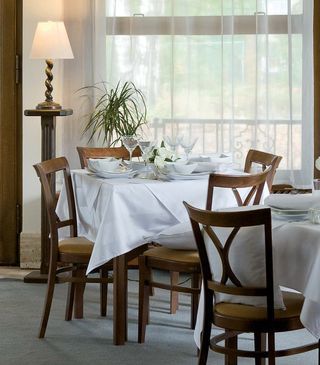 A wobbly table can disturb the conversation, so some cardboard or cork should be put under a possibly wobbly table leg in advance, so that this is excluded. Now the chairs must be placed. Make sure that there is enough legroom under the table for all guests. It should also be decided whether the end faces of a table should be occupied. In principle one counts 60-80 cm seat place per guest. The distance to the wall and sufficient elbow room must also be taken into account.
A wobbly table can disturb the conversation, so some cardboard or cork should be put under a possibly wobbly table leg in advance, so that this is excluded. Now the chairs must be placed. Make sure that there is enough legroom under the table for all guests. It should also be decided whether the end faces of a table should be occupied. In principle one counts 60-80 cm seat place per guest. The distance to the wall and sufficient elbow room must also be taken into account. -
Tablecloth: choice and size
Especially important for a festive meal is the table linen, especially an elegant tablecloth and matching cloth napkins. White tablecloths have a particularly noble effect; classic white damask tablecloths lend every meal a special festivity. Large, white damask tablecloths, as we offer them in our Tablecloths-Shop Libusch, also have the advantage that they can - in contrast to coloured tablecloths - be washed very hot. Stubborn stains in the white table linen, such as wine stains or dark juice stains, can also be washed out after the party by boiling them and, if necessary, by chlorine bleaching. The tablecloths appear again in a brilliant white and are ready for the next banquet. The size of the tablecloth should not be too small, but also not too large. You can determine the optimum size of a tablecloth by taking the size of the tabletop and adding an overhang of approx. 20-30 cm on each side. Depending on your taste, a slightly longer overhang can look very chic, but if you have a very large tablecloth, please remember to give your guests sufficient legroom and not least that the chairs should be pushed against the table and should not be obstructed by the tablecloth. And when choosing your tablecloth, don't forget that the most beautiful porcelain doesn't work if the base is inappropriate or even wrinkled and stained. Fine linen tablecloths are particularly noble and of high quality in any case.
-
Table linen: Table molleton and tablecloths
First a Molton base (table protector) is placed on the tabletop before the tablecloth follows. The table molton (molleton) dampens loud noises when dishes are placed on the table and creates a pleasantly soft feeling.
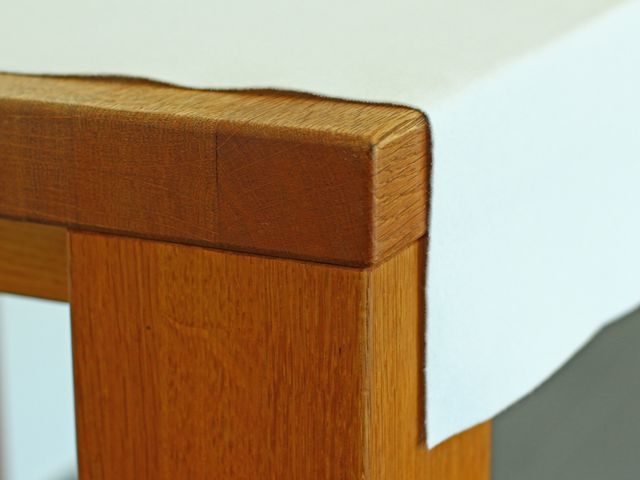 The edges and unevenness of the table are concealed and evened out, and the tablecloth underlay prevents the tablecloth from slipping. The tablecloth is then placed on these tablecloths. A tablecloth has three folds called fractures, which are also known as upper fracture, middle fracture and interruption. The upper break sometimes casts a slight shadow so that it should be as close as possible to the light source. When using particularly large tablecloths, such as those we offer in our Libusch tablecloth shop, these long tablecloths should always be laid by two people in order to achieve an exactly symmetrical tablecloth lay. Ideally, the upper break of the tablecloth lies exactly on the longitudinal centre of the table, halving the table to some extent. Also, make sure that there is an equal overhang on all sides of the table. After the tablecloth has been laid accurately, it is smoothed out by hand so that the damask tablecloth fits snugly against the Molton base and does not curl at any point. If several tablecloths are required for large tables, you should make sure that the fabric breaks lie exactly on top of each other and form a continuous line. The individual tablecloths should overlap by approx. 10 cm. If several tables are set in a room, all tablecloths should run with their breaks in the same direction. If central ceilings are also used, which is very festive, these central ceilings, also known as deck napkins (or table toppers), should be placed diagonally in the centre of the table. The corners of the central ceilings must under no circumstances be longer than the overhang of the tablecloth.
The edges and unevenness of the table are concealed and evened out, and the tablecloth underlay prevents the tablecloth from slipping. The tablecloth is then placed on these tablecloths. A tablecloth has three folds called fractures, which are also known as upper fracture, middle fracture and interruption. The upper break sometimes casts a slight shadow so that it should be as close as possible to the light source. When using particularly large tablecloths, such as those we offer in our Libusch tablecloth shop, these long tablecloths should always be laid by two people in order to achieve an exactly symmetrical tablecloth lay. Ideally, the upper break of the tablecloth lies exactly on the longitudinal centre of the table, halving the table to some extent. Also, make sure that there is an equal overhang on all sides of the table. After the tablecloth has been laid accurately, it is smoothed out by hand so that the damask tablecloth fits snugly against the Molton base and does not curl at any point. If several tablecloths are required for large tables, you should make sure that the fabric breaks lie exactly on top of each other and form a continuous line. The individual tablecloths should overlap by approx. 10 cm. If several tables are set in a room, all tablecloths should run with their breaks in the same direction. If central ceilings are also used, which is very festive, these central ceilings, also known as deck napkins (or table toppers), should be placed diagonally in the centre of the table. The corners of the central ceilings must under no circumstances be longer than the overhang of the tablecloth. -
Laying the table: Place plate and table decoration
The preparatory work is now complete and the table can be laid. The following
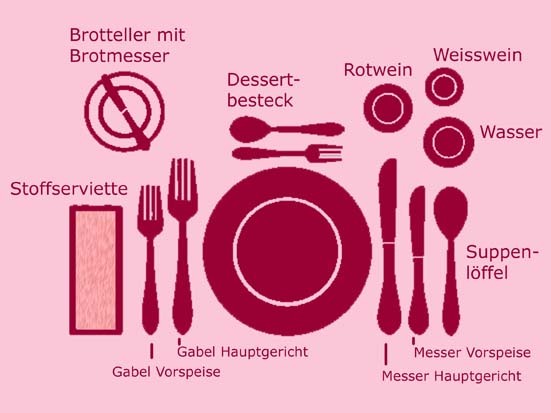 order applies: dishes - cutlery - glasses - napkins. Each place is first provided with a place plate. Remember to keep a distance of 60-80 cm per seat, otherwise your guests will sit too tightly. Silver-plated place plates look particularly elegant and, in addition to a white tablecloth, belong to the standard repertoire of a classically festive ambience. In order to be able to do the covering work better, turn the chairs 90° away from the table. In this way you also avoid unnecessary creases on the tablecloth. Now the flower decoration and the candles can follow. Here, too, a symmetrical arrangement looks best. Decorate your table with a festive multi-course menu. In the following you will also need lots of plates, cutlery and glasses. The correct placement of all utensils is as much an art as their use. The menu and the order of the meals determine the arrangement of the cutlery and the place setting.
order applies: dishes - cutlery - glasses - napkins. Each place is first provided with a place plate. Remember to keep a distance of 60-80 cm per seat, otherwise your guests will sit too tightly. Silver-plated place plates look particularly elegant and, in addition to a white tablecloth, belong to the standard repertoire of a classically festive ambience. In order to be able to do the covering work better, turn the chairs 90° away from the table. In this way you also avoid unnecessary creases on the tablecloth. Now the flower decoration and the candles can follow. Here, too, a symmetrical arrangement looks best. Decorate your table with a festive multi-course menu. In the following you will also need lots of plates, cutlery and glasses. The correct placement of all utensils is as much an art as their use. The menu and the order of the meals determine the arrangement of the cutlery and the place setting. -
Setting the table properly: crockery and cutlery
We are going on with the cutlery. Silver cutlery is now particularly popular again. Similar to classic white, large damask tablecloths, a new trend towards silver cutlery has been observed among young people for years. The cutlery is arranged logically, i. e. every guest should find the cutlery where he needs it. It is well known, cutlery is eaten from outside to inside, however cutlery is always covered from inside to outside. You should start with the main course knife. The knife is located to the right of the place plate, the cutting edge points to the left. The fork is placed to the left of the plate with its tines pointing upwards. If no place plate is used, the knife and fork must be separated from each other as far as possible. An accurately laid table must allow a plate to fit comfortably
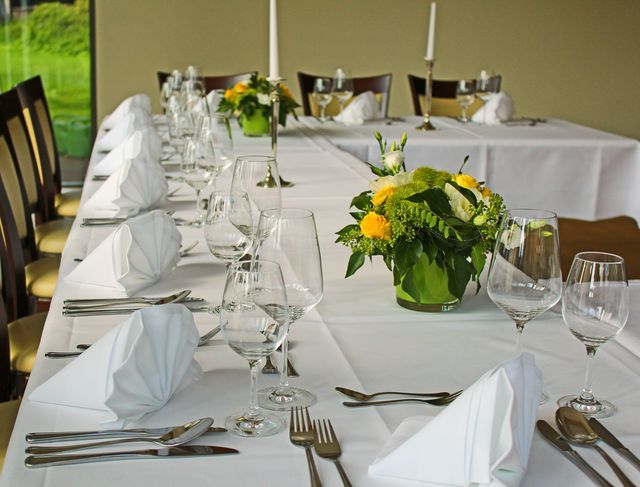 between them. If there is also a place setting on the other side of the table, the knife and fork should face each other in a straight line. The soupspoon is usually at the same height as the knife. The total width of the cutlery is always one finger (approx. 1 cm or one thumb) above the lower edge of the table. Now the knife and the fork for the starter follow on the right and left respectively. For the dessert the cutlery, which consists of a spoon and a fork, is placed over the plate. The fork comes across the plate with the handle pointing to the left, the spoon lies across the fork with the handle pointing to the right. Instead of a dessertspoon and fork, a coffee spoon and a cake fork can also be placed here, depending on the type of dessert prepared. If you have intended cheese as a dessert, the dessert knife is directly above the plate with the handle to the right above the fork with the handle to the left. If bread is served, there is a small plate for bread with a small knife next to the left row of cutlery, which is intended only for bread. Attention: Some dishes require special cutlery. These should be covered in advance or re-covered according to their handling. As a rule, the pliers are arranged on the left, for example lobster or screw pliers. Special forks such as lobster, snail, oyster and fondue forks must be placed to the right of the plate.
between them. If there is also a place setting on the other side of the table, the knife and fork should face each other in a straight line. The soupspoon is usually at the same height as the knife. The total width of the cutlery is always one finger (approx. 1 cm or one thumb) above the lower edge of the table. Now the knife and the fork for the starter follow on the right and left respectively. For the dessert the cutlery, which consists of a spoon and a fork, is placed over the plate. The fork comes across the plate with the handle pointing to the left, the spoon lies across the fork with the handle pointing to the right. Instead of a dessertspoon and fork, a coffee spoon and a cake fork can also be placed here, depending on the type of dessert prepared. If you have intended cheese as a dessert, the dessert knife is directly above the plate with the handle to the right above the fork with the handle to the left. If bread is served, there is a small plate for bread with a small knife next to the left row of cutlery, which is intended only for bread. Attention: Some dishes require special cutlery. These should be covered in advance or re-covered according to their handling. As a rule, the pliers are arranged on the left, for example lobster or screw pliers. Special forks such as lobster, snail, oyster and fondue forks must be placed to the right of the plate. -
Right tablecloths: Arranging the glasses
Finally, the glasses are arranged. Basically, there is a suitable glass for every drink. The glasses are covered on the right side above the cutlery according to the beverage sequence. The glass for the first drink is placed on the outside right. In total, no more than four glasses should be assigned to each guest. Belly style glasses are used for red wine; their large volume allows the bouquet of red wine to unfold optimally. White wine is served in smaller glasses so that it can always be enjoyed cool. In addition to wine glasses, a water glass should also always be covered. If beer is served with food, a beer tulip is a must. It promotes the formation of a crown of a slowly tapped beer. If sparkling wine is to be drunk, champagne goblets and not champagne bowls are to be preferred, since they keep the carbonic acid longer. Mouth-blown crystal glass can be recommended for all glasses, it corresponds best with fine white tablecloths and silver cutlery.
-
Setting the right table: The cloth fabric napkins can not be missing
At a real banquet, you should definitely
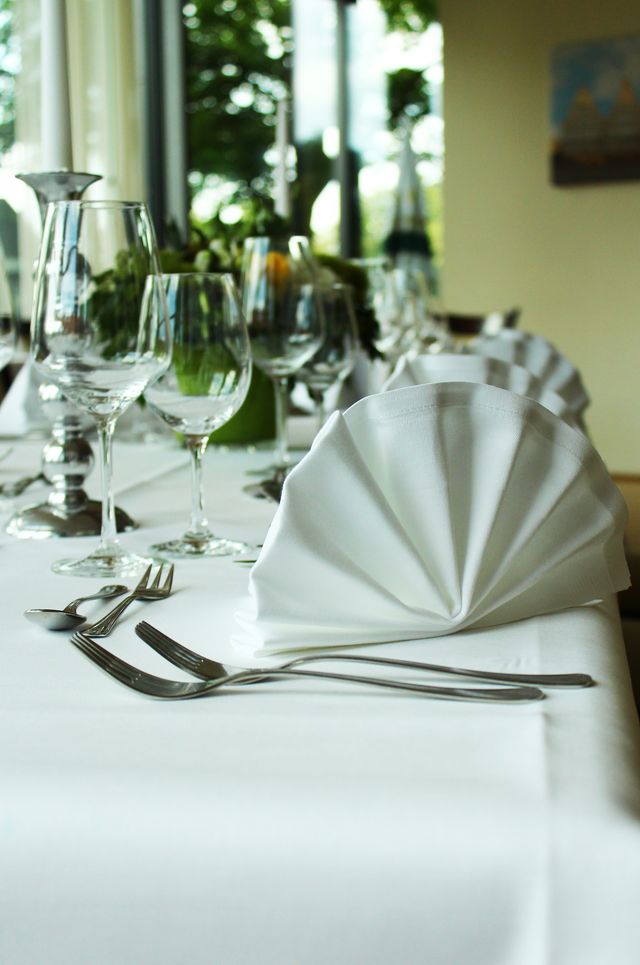 choose cloth napkins. Only cloth napkins give a meal a really upscale look. Matching the tablecloth, the napkins are the icing on the cake of your celebration. A fabric napkin always looks particularly beautiful in a napkin ring. Very appealing specimens are made of silver and then also match the silver cutlery. Today, however, it is modern to use different but unique napkin rings. Uniques possess their special charm. If you do not use napkin rings, place the slightly strengthened napkins on the plate or, if the first course is already there, on the left next to the left row of cutlery or on the bread plate. They can also be pleasantly folded, but one should refrain from all too daring creations. The suspicion that the napkin may not have remained completely clean during the complicated and time-consuming folding process must be avoided in any case.
choose cloth napkins. Only cloth napkins give a meal a really upscale look. Matching the tablecloth, the napkins are the icing on the cake of your celebration. A fabric napkin always looks particularly beautiful in a napkin ring. Very appealing specimens are made of silver and then also match the silver cutlery. Today, however, it is modern to use different but unique napkin rings. Uniques possess their special charm. If you do not use napkin rings, place the slightly strengthened napkins on the plate or, if the first course is already there, on the left next to the left row of cutlery or on the bread plate. They can also be pleasantly folded, but one should refrain from all too daring creations. The suspicion that the napkin may not have remained completely clean during the complicated and time-consuming folding process must be avoided in any case. -
The festive meal
Now your guests can come. When everyone is seated at the table, the meal begins with the outermost cutlery, usually the soup. Remember, only after the soup is in the plates, the wine is poured in. You go around the table and pour each guest from the right. After each meal, the plate with the used cutlery is cleared away. If bread is served, both the bread plate and the corresponding knife are removed after the main course. Cover the dessert cutlery to the left and right of the plate. We wish you a successful meal!
